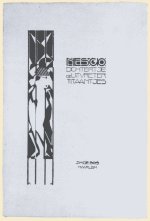
De Uitvreter/Titaantjes/Dichtertje
Nescio
130 pages
1909-1910/1914/1917
As you can probably guess Nescio (Latin for "I don't know") is a pseudonym; the author's real name is J. H. F. Gronlöh. The three novellas in this collection are the first stories he got published, as well as his most famous. Though long since recognised as one of the classic Dutch writers, at first he seemed destined for obscurity, writing few stories after these and his collection only slowly selling.
Nescio was unfortunate in that his style of writing, far more natural and realistic then was the norm at the time as well as the lengths at which he wrote were in disfavour with the reading public. People wanted novels, not novellas and they wanted beautiful writing, not natural. He also had a problem with his stories being slightly more risque and frank then his Dutch readers were used to and thought decent. Especially the light way in which he portrayed God in two of the stories was held against him.
That aspect of these three stories has, as I'm sure you'd already guessed, diminished a bit in the 85+ years since their first publication. Not that this has any influence on the quality of the stories, it just removes some of the impact of them, nothing more. Even if they were still as shocking as when they were published, these would be very gentle stories.
In fact, there's a quintessal Dutchness about them and an old fashioned sort innocence which we lost after World War II. After all, these stories were written from 1909-1917, when Holland, to quote the words of Heinrich Heine, was still fifty years behind the times. This resulted in a smug sort of bourgeois coziness, to which Nescio reacted, but which also is still visible in these stories.
In De Uitvreter ("The Loafer") the narrator tells about the strangest man he knew, save for the person who thought the Sarphatistraat was the most beautiful place in Europe. The loafer, always drinking on somebody else's costs, who always borrow your cigars, ate your bread and sausage, who loaned your books and never wore suits he paid for.
Yet not an unsympathetic figure, for all that, just somebody who saw no sense in working, in striving for anything, who'd most want to just sit there and look at the sea at Ijmuiden, no matter what the weather was like. A tragic figure in all, even if he seems more comical then tragic at first, because you know life doesn't treat boys like him well and indeed the story slowly quietly comes to its inevitable end.
Then in Titaantjes ("Little Titans"), the same narrator and as you suspect the writer himself tells about him and his friends. "Lads we were, but nice lads." Well brought up, well educated friendly lads, disdainful of their bourgeois background, swearing that they never would be like that, they would be different.
But you know and the narrator already knows that this will not be. In a nostalgic, accepting tone he tells the stories of all of them, how they ended up either satisfied with the role life forced them into or broken while fighting against it.
The last story in the collection, Dichtertje is about a young poet, a little poet as the title indicates. A poet with few worries, happily married, with one beautiful daughter a job he could tolerate and really only one wish: to be a great poet and then fall, to amaze the world for once and then fall in love with a lady poet.
He gets his wish in the form of the younger sister of his wife, who he at first doesn't notice other then as a child, but she is growing up and does indeed notice him... Meanwhile he moves on his way to his grave, becoming more respectable, climbing the ladder of social succes in a somewhat absentminded way but still with his poems in his head. And slowly but surely he and Dora spiral together into love, into consummation and then it's finished.
As I said, Nescio is very Dutch in his writing, the ways in which even the greatest crisis in these stories is treated gently and soberly, in the way he immediately tempers the emotional impact of scenes with a bit of humour. He was also very much an Amsterdammer and had a good sense of place, of describing the city in ways that still resonate today.
